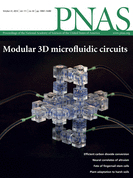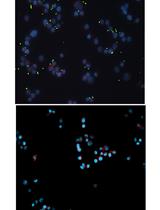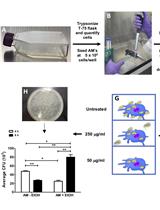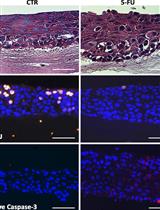- EN - English
- CN - 中文
Murine Leukemia Virus (MLV)-based Coronavirus Spike-pseudotyped Particle Production and Infection
基于鼠白血病病毒(MLV)的冠状病毒刺突假型颗粒的生产和感染
发布: 2016年12月05日第6卷第23期 DOI: 10.21769/BioProtoc.2035 浏览次数: 14882
评审: Longping Victor TseSmita NairAnonymous reviewer(s)
Abstract
Viral pseudotyped particles (pp) are enveloped virus particles, typically derived from retroviruses or rhabdoviruses, that harbor heterologous envelope glycoproteins on their surface and a genome lacking essential genes. These synthetic viral particles are safer surrogates of native viruses and acquire the tropism and host entry pathway characteristics governed by the heterologous envelope glycoprotein used. They have proven to be very useful tools used in research with many applications, such as enabling the study of entry pathways of enveloped viruses and to generate effective gene-delivery vectors. The basis for their generation lies in the capacity of some viruses, such as murine leukemia virus (MLV), to incorporate envelope glycoproteins of other viruses into a pseudotyped virus particle. These can be engineered to contain reporter genes such as luciferase, enabling quantification of virus entry events upon pseudotyped particle infection with susceptible cells. Here, we detail a protocol enabling generation of MLV-based pseudotyped particles, using the Middle East respiratory syndrome coronavirus (MERS-CoV) spike (S) as an example of a heterologous envelope glycoprotein to be incorporated. We also describe how these particles are used to infect susceptible cells and to perform a quantitative infectivity readout by a luciferase assay.
Keywords: Pseudotyped particle (假型颗粒)Background
Viral pseudotyped particles are very useful tools for studying the entry pathways that enveloped viruses use and for generating novel gene-delivery vectors. These synthetic enveloped viruses are derived from a parental virus, usually a rhabdovirus or a retrovirus, which forms the core of the particle that can incorporate in its membrane a wide range of viral envelope glycoproteins from heterologous viruses. Several model viruses such as the retroviral murine leukemia virus (MLV) and human immunodeficiency virus-1 (HIV-1) or the rhabdoviral vesicular stomatitis virus (VSV) have been successfully used to generate viral pseudotyped particles (also named pseudoviruses or pseudovirions). Virus pseudotyping is particularly useful for the following scenarios: (i) to quantify the viral entry process of enveloped viruses using reporter genes like green fluorescent protein (GFP) or luciferase, (ii) to study host cell entry of enveloped viruses that cannot be cultivated in cell culture, (iii) to study entry pathways of risk group (RG) 3 or 4 viral pathogens when biosafety level (BSL) 3 or 4 facilities are not available, (iv) to generate cells stably expressing a specific gene of interest or for specific gene silencing, (v) to produce vectors for gene delivery allowing control over cell tropism. Pseudotyped particles can be used to complement native virus infection assays, especially regarding study of virus entry events.
The protocol described here is highly adaptable both in terms of scale of production and type of envelope glycoprotein that can be incorporated. It has been extensively used in our research on viral entry of various enveloped viruses, including VSV (Sun et al., 2008), influenza virus (Tse et al., 2014) and coronaviruses (Belouzard et al., 2009; Millet and Whittaker 2014; Millet et al., 2016). We have successfully used this method to pseudotype viral envelope glycoproteins from all three classes of viral fusion proteins: influenza hemagglutinin (HA, class I), coronavirus spike (S, class I), Ebola glycoprotein (GP, class I), Semliki forest virus (SFV) E1 (class II), and vesicular stomatitis virus (VSV) G glycoprotein (class III). The technique described here is based on work performed by Bartosch and colleagues (Bartosch et al., 2003), and employs the so-called ‘three-plasmid’ co-transfection strategy in which producer HEK-293T/17 cells are co-transfected with the following plasmids: a plasmid allowing expression of MLV retroviral core genes gag and pol but lacking the MLV envelope glycoprotein-encoding env gene, a transfer vector containing a luciferase reporter gene flanked by retroviral regulatory LTR regions and a packaging signal, along with a plasmid allowing expression of the desired envelope glycoprotein. The co-expression of these three plasmids allows synthesis of LTR-flanked reporter gene-containing RNA, MLV-derived proteins and heterologous envelope glycoprotein. During pseudotyped particle formation, which occurs at the plasma membrane, the RNAs containing the LTR-flanked luciferase gene get incorporated into nascent particles formed by assembly and budding of MLV capsid proteins that also recruit heterologous viral envelope glycoproteins. Upon infection in susceptible cells, the pseudotyped virus entry pathway is solely governed by the heterologous virus envelope glycoprotein used. As such, pseudovirions are excellent surrogates to study the entry pathway of enveloped viruses. Once virus entry has occurred, the pseudotyped virus RNAs are released in the cell and the retroviral reverse transcriptase and integrase then reverse transcribe the molecules into double stranded DNA and integrate them into the genome of target cells. Because the sequence that gets integrated only contains the gene encoding the luciferase reporter but none of the MLV genes, the pseudotyped particles are inherently safer as they only allow for one round of infection. After infection, a simple luciferase assay allows quantification of infectivity of the pseudotyped particle studied.
The following protocol can form the basis of useful experiments for the study of the heterologous envelope glycoprotein function during virus entry, for example by performing the infection assay using different infection conditions such as receptor/co-receptor expression in target cells, virus binding time and temperature, pH, endocytosis inhibitors, protease inhibitors, neutralizing antibodies, etc.
Materials and Reagents
- Cell culture vessels, plates and tubes
- 50 ml Falcon tubes (TrueLine, catalog number: TR2004 )
- Cell counting slides with grids (KOVA, catalog number: 87144 )
- T75 75 cm2 cell culture flasks (TrueLine, catalog number: TR6002 )
- 6-well cell culture plates (TrueLine, catalog number: TR5000 )
- 24-well cell culture plates (TrueLine, catalog number: TR5002 )
- 1.5 ml Eppendorf tubes
- 0.22 µm cell culture medium filtration unit (LPS, catalog number: 1102-RLS )
- Pseudotyped virus solution filtration
- Pipettes and pipettors
- Pipettor set:
P1000 (Gilson, catalog numbers: F123602 )
P200 (Gilson, catalog numbers: F123601 )
P20 (Gilson, catalog numbers: F123600 ) - Stripettor for pipetting with serological pipette (Corning, catalog number: CLS4910-1EA )
Note: This product has been discontinued. - Sterile serological pipettes:
25 ml (LPS, catalog numbers: TR37129 )
10 ml (LPS, catalog numbers: TR37128 )
5 ml (LPS, catalog numbers: TR37127 ) - Repeater dispenser (Eppendorf, catalog numbers: 4981000.019 / 022260201 )
Note: This product has been discontinued.
10 ml sterile tips (Eppendorf, catalog numbers: 0030089677 )
5 ml sterile tips (Eppendorf, catalog numbers: 0030089561 )
- Pipettor set:
- Cells
- Transfection plasmids and reagents
- Plasmids pCMV-MLVgag-pol (ampicillin resistance) (Bartosch et al., 2003)
- pTG-Luc (ampicillin resistance) (Bartosch et al., 2003)
- pCAGGS-MERS-S (ampicillin resistance) (Millet and Whittaker, 2014)
- pCAGGS-VSV-G (ampicillin resistance)
- pCAGGS (ampicillin resistance)
- Lipofectamine 2000 (Thermo Fisher Scientific, InvitrogenTM, catalog number: 11668-027 )
- Opti-minimal essential medium (Opti-MEM) (Thermo Fisher Scientific, GibcoTM, catalog number: 31985-070 )
- Disinfection/decontamination reagents
- Ethanol (95%) (VWR, BDH®, catalog number: BDH1158-4LP ) diluted to 70% with water in spray bottle for surface disinfection
- Paper towels to soak in 70% ethanol and wipe surfaces to disinfect (Georgia-Pacific Consumer Products, catalog number: 23304 )
- Bleach solution for decontamination (The Clorox Company, catalog number: Germicidal Bleach )
- Cell culture reagents
- 0.25% trypsin EDTA solution (Mediatech, catalog number: 25-053-Cl )
- Dulbecco’s phosphate buffered saline (DPBS) with Ca2+ and Mg2+ (Mediatech, catalog number: 21-030-CV )
- Dulbecco’s modification of Eagles medium (DMEM) with 4.5 g/L glucose, L-glutamine but without sodium pyruvate (Mediatech, catalog number: 10-017-CV )
- Heat-inactivated fetal bovine serum (FBS) (Thermo Fisher Scientific, GibcoTM, catalog number: 1614071 )
- 100x penicillin-streptomycin (PS) solution (Mediatech, catalog number: 30-002-Cl )
- 1 M N-2-hydroxyethylpiperazine-N'-2-ethanesulfonic acid (HEPES) solution (Mediatech, catalog number: 25-060-Cl )
- Luciferase assay reagents
- Others
- Cryovials
- Complete DMEM (DMEM-C) (see Recipes)
- Transfection DMEM (DMEM-T) (see Recipes)
Equipment
- Temperature-controlled water bath (Labnet, model: W1106A )
- Biosafety cabinet (Class II-A2) connected to a vacuum aspiration system (Labconco, model: 3440009 )
- Inverted light microscope with 10x objective (Nikon Instruments, model: TS100 ) for checking cell density and health
- Plate rocker in 37 °C 5% CO2 cell culture incubator (Thermo Fisher Scientific, Fisher ScientificTM, model: 13-687-704 )
- Plate rocker, room temperature (VWR, model: 40000-300 )
- 37 °C 5% CO2 humidified cell culture incubator – Symphony (VWR, model: 98000-368 )
- Vortex Genie (Scientific Industries, model: G560 )
- Pocket calculator (Sharp Elsimate, Sharp, model: EL-334TB )
- Inverted light microscope with 10x objective (Carl Zeiss, model: Axiovert 200 ) connected to a CCD camera (PCO, model: Sensicam QE )
- Centrifuge (Eppendorf, model: 5810R )
- GloMax 20/20 luminometer (Promega, model: 2030-100 )
- Lab refrigerator set at 4 °C (GE Appliances, model: GMR06AAMBRWW )
- Lab freezer set at -20 °C (SUMMIT APPLIANCE, model: FS-603 )
- Lab freezer set at -80 °C (Thermo Fisher Scientific, Thermo ScientificTM, model: UXF30086A )
- Timer (VWR, catalog number: 61161-346 )
Software
- Prism (GraphPad, version 7)
Procedure
文章信息
版权信息
© 2016 The Authors; exclusive licensee Bio-protocol LLC.
如何引用
Millet, J. K. and Whittaker, G. R. (2016). Murine Leukemia Virus (MLV)-based Coronavirus Spike-pseudotyped Particle Production and Infection. Bio-protocol 6(23): e2035. DOI: 10.21769/BioProtoc.2035.
分类
微生物学 > 微生物-宿主相互作用 > 病毒
微生物学 > 微生物-宿主相互作用 > 体外实验模型 > 细胞系
分子生物学 > DNA > 转染
您对这篇实验方法有问题吗?
在此处发布您的问题,我们将邀请本文作者来回答。同时,我们会将您的问题发布到Bio-protocol Exchange,以便寻求社区成员的帮助。
提问指南
+ 问题描述
写下详细的问题描述,包括所有有助于他人回答您问题的信息(例如实验过程、条件和相关图像等)。
Share
Bluesky
X
Copy link













